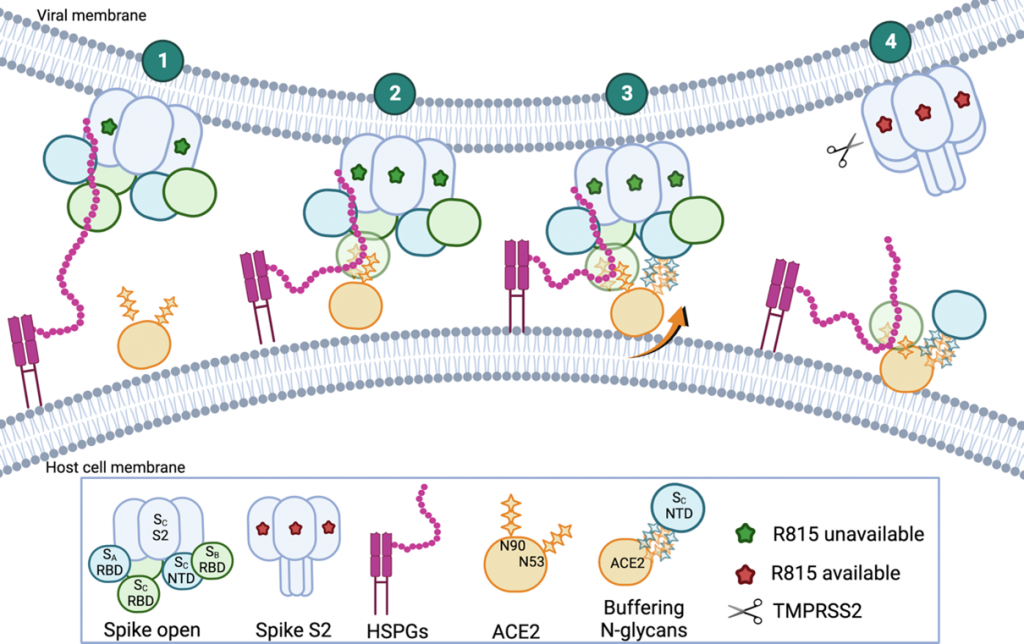Polysaccharides on Cells: Accomplices in SARS-CoV-2 infection
An international team of scientists in Germany and Italy have published new findings on how specific polysaccharides act as accomplices in the SARS-CoV-2 infection mechanism. The results of their study represent a crucial step in understanding the mechanisms that make SARS-CoV-2 such a harmful pathogen. Moreover, they open up new avenues for combating COVID-19 and for more effective treatments in the future.
As the world continues to grapple with COVID-19, scientists at Heidelberg Institute for Theoretical Studies (HITS) and Heidelberg University have gained valuable insights into the mechanisms that allow the SARS-CoV-2 virus to infect certain human cells, shedding light on why some patients are more vulnerable to the virus. Their study, published in the Proceedings of the National Academy of Sciences USA (PNAS), highlights the critical role played by specific polysaccharides expressed on the host cell surfaces called heparan sulfate and on the protein called N-glycans.

Not only just “helpers”: Heparan sulfate and N-glycans
SARS-CoV-2, the virus responsible for COVID-19, infects cells through attaching its spike glycoprotein to the ACE2 receptor on human cells. However, this binding is not as simple as a lock and key. Heparan sulfate and N-glycans were previously considered to be just ‘helpers,’ aiding the interaction between the viral spike and the host cell receptor ACE2. However, their variable expression in different cells and individuals appears to correlate with the virus’s ability to infect these cells. “We were therefore interested in a deeper understanding of how heparan sulfates are involved in the SARS-CoV-2 infection mechanism and how they relate to host cell susceptibility,” says HITS group leader Rebecca Wade.
By performing atomic-detail molecular dynamics simulations, the researchers investigated the role played by heparan sulfate and N-glycans in the spike/ACE2 interaction and examined how the complex dynamics depends on the presence of heparan sulfates. “Only by using simulations could we analyze the molecular details and see that heparan sulfate and N-glycans synergistically strengthen the spike/ACE2 complex,” says Giulia Paiardi, the first author of the study. “This effect results from structural rearrangements and the propagation of forces in the spike upon ACE2 and heparan sulfate binding.”
This discovery unlocks potential new therapeutic approaches for combating SARS-CoV-2. “If we can develop suitable heparan sulfate mimetics, we might be able to prevent the virus from binding to and entering human cells,” Rebecca Wade concludes.
The study has received funding from the German Research Foundation (DFG) (grant #458623378), the Klaus Tschira Foundation, the AI Health Innovation Cluster, the Joachim Herz Stiftung (Add-on fellowship for Interdisciplinary Life Science), and the CAPES/DAAD bi-nationally supervised doctoral degree (grant #57507871). Computing resources provided by HITS, Baden-Württemberg bwHPC, and the German Research Foundation (DFG) through grant INST 35/1134-1 and INST 35/1597-1 FUGG were used.
Publication:
Paiardi G, Ferraz M, Rusnati M, Wade RC. The accomplices: Heparan sulfates and N-glycans foster SARS-CoV-2 spike: ACE2 receptor binding and virus priming. PNAS, Vol 121 | No 43, e2404892121 (14 October 2024) https://www.pnas.org/doi/10.1073/pnas.2404892121
Scientific Contact:
Prof. Dr. Rebecca Wade
Molecular and Cellular Modeling group
Heidelberg Institute for Theoretical Studies (HITS)
Phone: +49 6221 533 245
rebecca.wade@h-its.org
Dr. Giulia Paiardi
Molecular and Cellular Modeling group
Heidelberg Institute for Theoretical Studies (HITS)
giulia.paiardi@h-its.org
Media Contact:
Dr. Peter Saueressig
Head of Communications
Heidelberg Institute for Theoretical Studies (HITS)
About HITS
HITS, the Heidelberg Institute for Theoretical Studies, was established in 2010 by physicist and SAP co-founder Klaus Tschira (1940-2015) and the Klaus Tschira Foundation as a private, non-profit research institute. HITS conducts basic research in the natural, mathematical, and computer sciences. Major research directions include complex simulations across scales, making sense of data, and enabling science via computational research. Application areas range from molecular biology to astrophysics. An essential characteristic of the Institute is interdisciplinarity, implemented in numerous cross-group and cross-disciplinary projects. The base funding of HITS is provided by the Klaus Tschira Foundation.